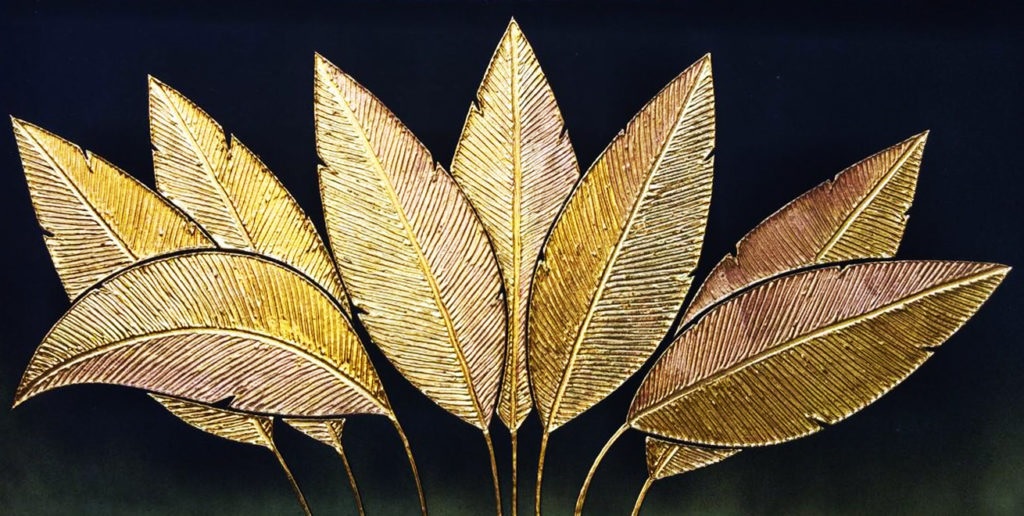The term “Gold Leaf Annapolis” brings to mind both the elegance of this luxury finish and its presence in the beautiful coastal city of Annapolis. Whether you’re seeking information on the art of gold leafing, the gold leaf strain, or the diverse applications of gold leaf sheets, Annapolis offers a rich history intertwined with the artistry and applications of this unique medium. This article explores the fascinating details and uses of gold leaf, from its ancient origins to modern applications.
Understanding Gold Leaf: History, Production, and Uses

Gold leaf is an extremely thin sheet of gold, used for decorating and gilding objects, enhancing them with the gleam and luxury of gold. Gold leafing is the process of applying this delicate material to surfaces, transforming ordinary items into stunning works of art.
Origins and History of Gold Leaf
Gold leaf has been used since ancient times, with records showing that the Egyptians, Greeks, and Romans incorporated it in artwork, architecture, and religious icons. Often symbolizing wealth, power, and divinity, gold leaf was applied to statues, buildings, manuscripts, and even clothing.
In the Middle Ages, gold leaf became popular in European religious art, often used to decorate church interiors and manuscripts. This tradition continues today, with gold leaf being a key component in architectural restoration, artwork, furniture, and luxury home decor.
Production of Gold Leaf
The production of gold leaf is a complex and labor-intensive process that requires specialized tools and skilled craftsmanship. Here’s a simplified breakdown:
- Gold Purification: Pure gold is melted and alloyed with other metals if necessary, depending on the desired color and durability.
- Rolling: The gold is rolled into thin sheets using a mechanical roller.
- Beating: The rolled sheets are hammered or mechanically beaten to achieve an extremely thin consistency. Each sheet can be as thin as 1/250,000 of an inch.
- Cutting and Packaging: The sheets are carefully cut and packaged to prevent damage, as they are very delicate and can tear or wrinkle easily.
Applications of Gold Leaf
Gold leaf has a wide range of applications in various industries:
- Interior Decoration: Gold leaf adds luxury to walls, ceilings, moldings, and picture frames, creating opulent, refined spaces.
- Art and Sculptures: Artists use gold leaf in paintings, sculptures, and mixed-media artworks to achieve a unique finish that stands out.
- Furniture: Antique furniture and luxury home items are often gilded with gold leaf to enhance their value and appearance.
- Cosmetics and Culinary Uses: Edible gold leaf is used as a garnish in fine dining, chocolates, pastries, and cocktails for a luxurious touch.
Gold Leaf Sheets: Versatile Applications and Types

Gold leaf sheets are sheets of ultra-thin gold that can be used for a variety of artistic, decorative, and practical applications. The sheets come in different karats and tones, depending on the purity and color desired.
Types of Gold Leaf Sheets
Gold leaf sheets vary in purity and color. Here are the most common types:
- 24K Gold Leaf Sheets: The purest form of gold leaf, offering a deep, yellow color and is often used for religious artifacts, high-end artwork, and interior gilding.
- 22K and 18K Gold Leaf Sheets: Slightly less pure than 24K but still luxurious, these sheets are used in artwork, frames, and decorative furniture.
- Imitation Gold Leaf: Made from a blend of metals, usually brass, to mimic real gold. This is a cost-effective option and is used for projects where pure gold isn’t necessary.
- Edible Gold Leaf Sheets: Safe for consumption, edible gold leaf is used in culinary arts and can enhance fine foods and beverages with a luxurious touch.
Using Gold Leaf Sheets
Applying gold leaf sheets requires precision and patience. Here’s a step-by-step guide:
- Prepare the Surface: Ensure the surface is smooth, clean, and coated with an adhesive called “size.”
- Apply the Size: Paint the size onto the surface, and wait until it becomes tacky.
- Place the Gold Leaf: Carefully place the gold leaf sheet on the adhesive, gently pressing it into place with a soft brush.
- Seal the Gold Leaf: After applying the gold leaf, seal it with a protective coating to preserve the shine and prevent tarnishing.
Gold Leaf Strain: A Unique Cannabis Variety
In addition to its traditional uses, “Gold Leaf” is also a well-known strain in the world of cannabis. Created by the legendary cannabis breeder Robert Bergman, Gold Leaf strain has garnered a reputation for its potency, medicinal benefits, and enjoyable effects.
Characteristics of the Gold Leaf Strain
The Gold Leaf strain is an Indica-dominant hybrid (about 60% Indica, 40% Sativa) that combines genetics for both physical relaxation and mental clarity. Its popularity can be attributed to several key traits:
- Appearance: Gold Leaf buds are dense and coated with golden trichomes, which give them their signature “golden” look.
- Aroma and Flavor: This strain has a rich, earthy aroma with notes of pine, citrus, and spice. The flavor profile is smooth, with hints of sweet and spicy herbs.
- THC and CBD Content: Gold Leaf has a high THC content (around 18-23%) and a moderate CBD level, making it ideal for medicinal and recreational use.
Growing Gold Leaf Strain
The Gold Leaf strain is known for its high yield and resilience, making it a popular choice for both novice and experienced growers.
- Climate Requirements: Gold Leaf grows best in warm, sunny climates but can also thrive indoors under the right conditions.
- Flowering Time: This strain has a short flowering time of around 8-9 weeks, allowing for faster harvest cycles.
- Yields: Gold Leaf is known for its large yields, with outdoor plants producing up to 28 ounces per plant, and indoor setups yielding up to 23 ounces per square meter.
- Height and Growth Pattern: This strain tends to grow tall and bushy, making it ideal for Sea of Green (SOG) or Screen of Green (SCROG) setups.
Medicinal Benefits of Gold Leaf Strain
Gold Leaf is often used by patients seeking relief from chronic pain, stress, anxiety, and insomnia. The strain’s balanced effects can provide physical relaxation and mental clarity, helping users manage symptoms without excessive sedation.
Where to Find Gold Leaf Annapolis

In Annapolis, you can find both gold leaf supplies and expert gilders who specialize in various applications, from furniture restoration to artistic projects. Additionally, some stores in Annapolis may carry the Gold Leaf strain, though availability depends on local regulations.
Gold Leafing Studios and Suppliers in Annapolis
Several businesses in Annapolis offer gold leafing services and materials for home decor, art projects, and antique restoration. Whether you are an artist, a hobbyist, or simply looking to add a touch of luxury to your home, Annapolis has options for sourcing high-quality gold leaf.
Cannabis Dispensaries in Annapolis
For those interested in the Gold Leaf strain for its medicinal or recreational benefits, local dispensaries may offer this strain. Make sure to check the dispensary’s current stock and availability of this popular cannabis variety.
Conclusion: Embracing Gold Leaf in Annapolis
From the stunning applications of gold leaf sheets in art and decor to the potent Gold Leaf cannabis strain, the allure of gold leaf is multifaceted. In Annapolis, this unique medium finds its place among artists, decorators, and cannabis enthusiasts alike. The legacy of gold leaf and its enduring beauty ensure that it will remain a prized material across diverse industries.
Whether you’re exploring gold leaf as an artistic element or seeking the unique qualities of the Gold Leaf strain, Annapolis provides a rich setting for experiencing this material in all its forms.







